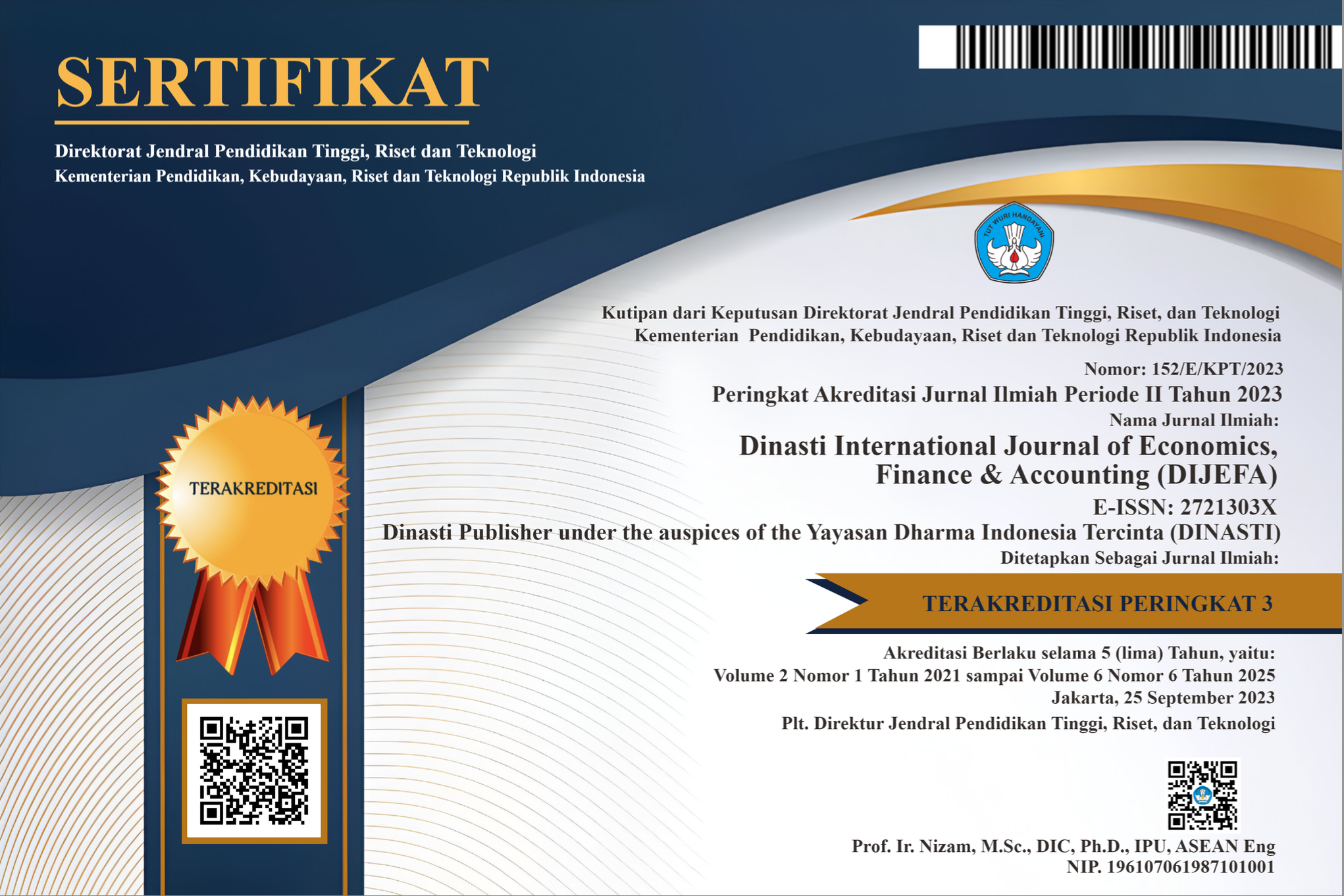Analysis of Accounts Receivable Turnover at PT. The Core of Sumatran Success in 2021
DOI:
https://doi.org/10.38035/dijefa.v2i4.1371Keywords:
Accounts Receivable Turnover, Accounts Receivable Collection Period, Arrears Ratio, Billing RatioAbstract
This study aims to analyze how big the level of receivables turnover on sales made by PT. Inti Sukses Sumatera in 2021. In the midst of intense business competition, companies are required to be able to achieve market position, so companies need to carry out a credit sales strategy, so that the number of sales increases. Receivables in general can be defined as claims or arising from the sale of goods or services on credit with a predetermined period of time as a result of credit sales. Receivables are a type of current asset listed on the balance sheet. Receivables can be potential if managed properly but otherwise will be a risk if not managed properly. The research method used is descriptive quantitative method, namely research that uses numerical data (numbers), which is then processed and analyzed to draw conclusions. Data collection techniques used are interviews and documentation. From this data is analyzed using ratio analysis, especially those related to receivables turnover rate, receivable collection period, arrears ratio and billing ratio. The results of the study are: (1) The ratio of the receivables turnover rate of PT. Inti Sukses Sumatera during the first semester of 2021 was 8 times and the second semester decreased to 7 times, so that the collection made by management is considered successful, (2) in the first semester the average collection period of receivables is 43 days in the first six months of the year. 2021. In the second semester the average collection of receivables at PT Inti Sukses Sumatra during 2021 is slower to 52 days, so it can be said that the company is able to collect on time, (3) that the ratio of arrears is 1.180% in the first semester and second semester of 0.97%. Arrears of more than 1% occur in the first semester and can harm the company because the funds that should be revolving will remain embedded in receivables, (4) the above collection ratio in the first six months of 2021 is 98.83 and 99.04% in the second semester . So that the company is able to do well in collecting receivables.
References
Diana Tambunan, 2016. Analysis of Accounts Receivable Turnover at PT. Perdana Gapura Prima Period 2012-2014, Proceedings of the INDOCOMPAC National Seminar, Bakrie University, Jakarta. 2-3 May 2016
Dr. Mamduh., M. Hanafi, MBA, and Dr. Abdul Halim, MBA, Akt.(2016). Financial Statement Analysis. Yogyakarta
Ephraim Ferdinand Giri. 2017. Intermediate Financial Accounting 1 . Yogyakarta: UPP STIM YKPN.
Featy Octaviany, Kustari, Nofi Anasari, 2020. Analysis of accounts receivable turnover at PT. Anugrah Textile in Jakarta , Journal of Lantern Accounting P-ISSN 2339-2991 Volume 5 Number 1, May 2020
Hafsah, & Sari, SS (2015). Capital Structure Analysis on Financial Performance in Property and Real Estate Companies Listed on the IDX . Journal of Accounting and Business Research, 15(1), 52–64.
Harry. 2017. Accounting Theory, Conceptual Approach and Analysis . Jakarta: Grasindo.
Husnaeni, 2017. Analysis of Accounts Receivable Turnover Against Receivable Management At PT. Sinar Galesong Mandiri Makassar , Thesis of Accounting Department, Faculty of Economics & Business, University of Muhammadiyah Makassar 2017
Indonesian Accounting Association (2012), Financial Accounting Standards. Jakarta a : Salemba Empat.
Indonesian Institute of Accountants. 2015. Financial Accounting Standards .
Indonesian Accounting Association. PSAK No. 1 Regarding Financial Statements – revised edition 2015. Publisher of the Financial Accounting Standards Board: PT. King of Grafindo
cashmere. 2019. Financial Statement Analysis . First Edition. Twelfth Printing. PT Raja Grafindo Persada. Jakarta
cashmere. 2017. Analysis of Financial Statements. Edition One. Jakarta: PT RajaGrafindo Persada.
Muhammad Nuruzzaman, Isna Yuningsih, Musviyanti, 2018. Analysis of accounts receivable turnover, Mulawarman Journal of Accounting, Vol 3, No 2 2018
Munawir. 2016. Analysis of Financial Statements, Second Edition. Liberty : Yogyakarta.
Mulyadi. 2017. Accounting System. Fourth Edition. Jakarta: Four Salemba.
Mulyadi. 2016. Accounting System. Fourth Edition. Jakarta: Four Salemba.
Mustafa. 2017. Financial Management . Yogyakarta: CV. Andi Offset.
M. Basri Kamal, 2016, “The Effect of Receivable Turn Over and Debt To Asset Ratio (DAR) on Return On Assets (ROA) in Agricultural Companies Listed on the Indonesia Stock Exchange (IDX), Scientific Journal of Management and Business, Vol. 17 No. 02, 68-81.
Rachmawati, S., & Nurjanah. (2017). Implementation of Financial Data with Zahir Accounting at Pt Anugerah. 5(2), 267–273. https://doi.org/10.30871/jaemb.v5i2.537
PSAK 55 (Section 1). Accessed on 20 May 2021, from https://accountingunsoed.org/accounting-standar-resume-psak-55/
Sugiyono. (2017). Quantitative, Qualitative, and R&D Research Methods . Bandung : Alfabeta, CV.
Sugiyono (2019). Quantitative, Qualitative, and R&D Research Methods. Bandung: Alphabet.
S. Munawir. 2015. Analysis of Financial Statements. Yogyakarta : Liberty.
Sujarweni, V. Wiratna. (2017). Financial Statement Analysis : Theory, Application, & Research Results. Yogyakarta: New Press Library.
Warren, Carls S., et al. 2017. Introduction to Indonesian Adaptation-Accounting . Twenty-Fifth Edition. Fourth Printing. Volume 1. Salemba Four. Jakarta.
Yunus, Riani Sukma Wijaya, 2021. Analysis of the Effectiveness of Management and Receivable Control Systems at PT. Gunung Naga Distribution , Journal of Economics and Business, Dharma Andalas, Volume 23 NO 2, July 2021.
cashmere. 2015. Analysis of Financial Statements. Edition One. Jakarta: PT RajaGrafindo Persada.
Downloads
Published
How to Cite
Issue
Section
License
Authors who publish their manuscripts in this journal agree to the following conditions:
- The copyright on each article belongs to the author(s).
- The author acknowledges that the Dinasti International Journal of Economics, Finance & Accounting (DIJEFA) has the right to be the first to publish with a Creative Commons Attribution 4.0 International license (Attribution 4.0 International (CC BY 4.0).
- Authors can submit articles separately, arrange for the non-exclusive distribution of manuscripts that have been published in this journal into other versions (e.g., sent to the author's institutional repository, publication into books, etc.), by acknowledging that the manuscript has been published for the first time in the Dinasti International Journal of Economics, Finance & Accounting (DIJEFA).


























































